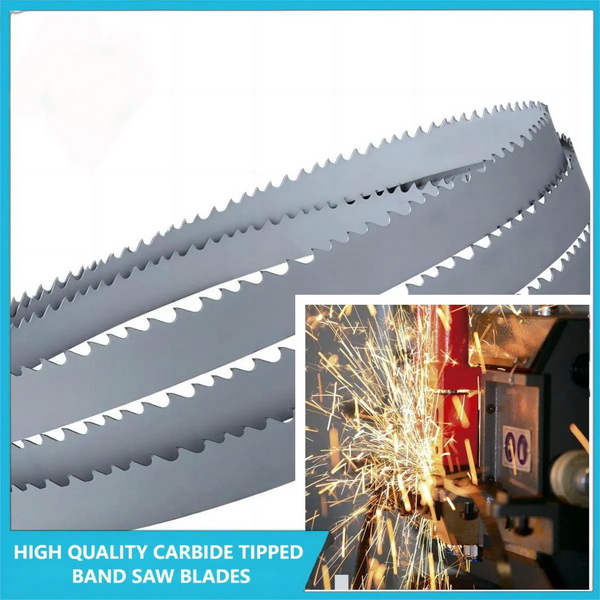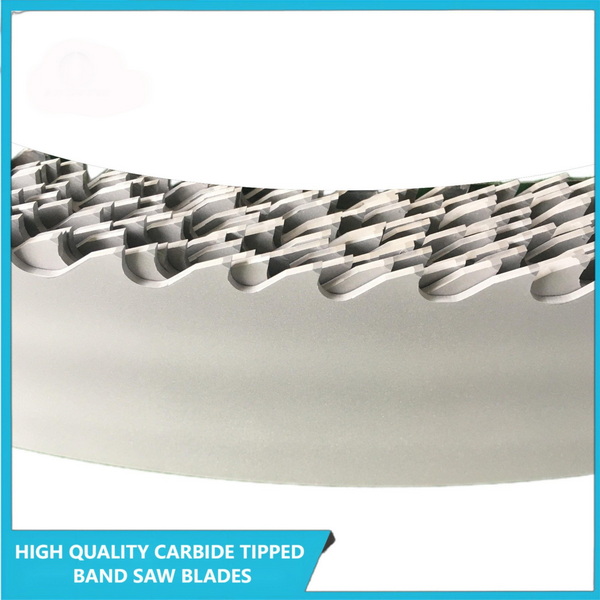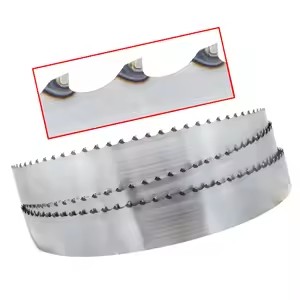Content Menu
● Introduction
● What is Tungsten Carbide?
>> Properties of Tungsten Carbide
● Types of Tungsten Carbide Bandsaw Blades
>> 1. Tungsten Carbide Tipped (TCT) Blades
>> 2. Tungsten Carbide Grit Blades
>> 3. Specific Application Blades
● Benefits of Using Tungsten Carbide Bandsaw Blades
>> Increased Durability and Lifespan
>> Enhanced Cutting Performance
>> Versatility
● Applications of Tungsten Carbide Bandsaw Blades
>> Metalworking
>> Woodworking
>> Manufacturing
● Factors to Consider When Choosing a Tungsten Carbide Bandsaw Blade
>> Material Type
>> Cutting Speed and Feed Rate
>> Desired Finish
● Maintenance and Care of Tungsten Carbide Bandsaw Blades
>> Regular Inspection
>> Cleaning
>> Storage
● Conclusion
● FAQ
>> 1. What are the main advantages of using tungsten carbide bandsaw blades?
>> 2. How do I choose the right tungsten carbide blade for my application?
>> 3. What is the difference between TCT and tungsten carbide grit blades?
>> 4. How often should I replace my tungsten carbide bandsaw blade?
>> 5. Can tungsten carbide bandsaw blades be sharpened?
● Citations:
Introduction
Bandsaw blades are essential tools in various industries, including woodworking, metalworking, and construction. The effectiveness of a bandsaw blade depends largely on the material it is made from. Among the advanced materials used in bandsaw blades, tungsten carbide stands out due to its exceptional properties. This article explores the characteristics, benefits, applications, and types of tungsten carbide, providing a comprehensive understanding of why they are a preferred choice for many demanding cutting tasks.

What is Tungsten Carbide?
Tungsten carbide (WC) is a composite material comprising tungsten and carbon atoms. It is known for its high hardness, strength, and wear resistance. Typically, tungsten carbide is combined with a binder metal, such as cobalt, to enhance its toughness. The resulting material is incredibly robust and capable of maintaining a sharp cutting edge even at high temperatures[3].
Properties of Tungsten Carbide
- Hardness: Tungsten carbide is nearly twice as hard as steel, making it ideal for cutting abrasive materials[7].
- Heat Resistance: It can withstand much higher temperatures than steel without losing its hardness or strength[3].
- Wear Resistance: Tungsten carbide blades last longer than conventional steel blades, reducing the frequency of blade changes[3].
- Cutting Performance: They produce superior finishes and clean cuts, reducing the need for secondary finishing processes[3].
Types of Tungsten Carbide Bandsaw Blades
Several types of tungsten carbide bandsaw blades are available, each designed for specific applications. These blades differ in tooth geometry, rake angle, and carbide grade, allowing them to handle a wide range of materials and cutting conditions[7].
1. Tungsten Carbide Tipped (TCT) Blades
TCT blades feature tungsten carbide tips brazed onto a steel body. These blades are designed for cutting alloy steel, stainless steel, and other tough materials[1].
Features:
- High-speed steel body with tungsten carbide material on the blade teeth[3].
- Triple chip ground carbide tips for a smooth surface finish[1].
- High chrome and moly steel backer for exceptional fatigue life[1].
Advantages:
- Excellent wear resistance in abrasive and hard-to-cut materials[2].
- Increased service lifetime for volume production sawing[2].
- Ability to cut a wide range of materials, including wood, aluminum, carbon steels, and alloy steels[1].
2. Tungsten Carbide Grit Blades
These blades have tungsten carbide grit metallurgically bonded to the edges. They are particularly effective for cutting hard and brittle materials[5].
Features:
- Metallurgically bonded tungsten carbide grit forms permanent cutting edges[5].
- Available in various grit sizes (coarse, medium) depending on the application[5].
- Continuous or gulleted edges for different material thicknesses[5].
Advantages:
- Cuts longer and tougher materials compared to toothed blades[5].
- Reduces the risk of breaking brittle material due to the grinding action[5].
- Suitable for cutting aircraft and sheet stainless steel, composites, glass, stone, and titanium[5].
3. Specific Application Blades
Some manufacturers offer specialized tungsten carbide blades tailored for specific materials or cutting tasks[7]. Examples include:
- STC Blades: Designed for highly abrasive materials like aluminum castings and fiberglass[7].
- T3N Blades: Feature a negative rake angle for cutting case-hardened materials and ensuring a smooth finish[7].
- T3P Blades: Production workhorses with high cutting capacities for heavier substrates like nickel and titanium[7].
- T7P Blades: Offer superior cutting and heat resistance for larger-sized parts and tough materials[7].
Benefits of Using Tungsten Carbide Bandsaw Blades
The use of tungsten carbide bandsaw blades provides several advantages over traditional steel blades. These benefits contribute to increased productivity, cost savings, and improved cutting quality[3].
Increased Durability and Lifespan
Tungsten carbide blades are significantly more durable than standard steel blades. Their superior hardness and wear resistance mean they stay sharper for longer, reducing the need for frequent replacements[3].
- Cost Savings: The extended lifespan of tungsten carbide blades translates to lower blade costs over time[3].
- Reduced Downtime: Fewer blade changes mean less downtime, increasing overall productivity[3].
Enhanced Cutting Performance
Tungsten carbide blades offer superior cutting performance, particularly when dealing with hard or abrasive materials. They maintain their cutting edge even under high temperatures, ensuring consistent and precise cuts[3].
- Faster Cutting Speeds: Carbide tools enable cutting at higher speeds and feeds, increasing production rates[3].
- Improved Finish: Tungsten carbide blades produce cleaner and smoother cuts, reducing the need for secondary finishing processes[3].
Versatility
Tungsten carbide blades are versatile and can be used to cut a wide range of materials. They are suitable for cutting everything from wood and aluminum to hardened steels and superalloys[1].
- Wide Range of Applications: Suitable for various industries, including woodworking, metalworking, aerospace, and automotive[3].
- Adaptability: Different blade types and tooth geometries allow for customization based on specific cutting requirements[7].
Applications of Tungsten Carbide Bandsaw Blades
Tungsten carbide bandsaw blades are used in a wide array of applications across various industries[3]. Their ability to cut through tough materials and maintain a sharp edge makes them indispensable in demanding cutting operations.
Metalworking
In metalworking, tungsten carbide blades are used to cut various metals, including steel, stainless steel, aluminum, and exotic alloys. They are particularly effective for cutting hardened steels and superalloys that would quickly dull conventional blades[1].
- Cutting Hardened Steels: Ideal for cutting tool steels, die steels, and other hardened materials[9].
- Cutting Superalloys: Used in the aerospace industry for cutting titanium, nickel-based alloys, and other high-performance materials[7].
- General Metal Cutting: Provides longer life and faster cutting speeds compared to traditional blades[6].
Woodworking
While not as common as in metalworking, tungsten carbide blades are also used in woodworking, particularly when cutting abrasive or composite wood materials[1].
- Cutting Hardwoods: Suitable for cutting dense hardwoods like oak, maple, and teak[1].
- Cutting Composites: Effective for cutting plywood, MDF, and other engineered wood products[5].
- Cutting Abrasive Woods: Ideal for cutting wood species that contain high levels of silica or other abrasive compounds[5].
Manufacturing
In manufacturing, tungsten carbide blades are used in a variety of cutting applications, including the production of automotive parts, aerospace components, and industrial machinery[3].
- Automotive Industry: Cutting steel and aluminum components for vehicles[1].
- Aerospace Industry: Manufacturing parts from titanium and superalloys[7].
- General Manufacturing: Cutting various materials in the production of industrial equipment and machinery[6].

Factors to Consider When Choosing a Tungsten Carbide Bandsaw Blade
Selecting the right tungsten carbide bandsaw blade for a specific application requires careful consideration of several factors. These include the material being cut, the cutting speed, and the desired finish[7].
Material Type
The type of material being cut is one of the most important factors to consider. Different materials require different blade types and tooth geometries[7].
- Hardness: Harder materials require blades with higher carbide content and more robust tooth designs[7].
- Abrasiveness: Abrasive materials require blades with high wear resistance to prevent premature dulling[3].
- Thickness: Thicker materials may require blades with a different tooth pitch and gullet depth to ensure efficient cutting[5].
Cutting Speed and Feed Rate
The cutting speed and feed rate also affect blade selection. Higher cutting speeds may require blades with better heat resistance and more robust tooth designs[3].
- Speed: Faster cutting speeds can generate more heat, requiring blades with high heat resistance[3].
- Feed Rate: Higher feed rates can put more stress on the blade, requiring a more durable construction[3].
Desired Finish
The desired finish also plays a role in blade selection. Blades with finer teeth and more precise grinding produce smoother finishes[1].
- Tooth Geometry: Blades with triple chip grind (TCG) tooth geometry produce smoother finishes[1].
- Blade Condition: Maintaining sharp blades is essential for achieving the desired finish[3].
Maintenance and Care of Tungsten Carbide Bandsaw Blades
Proper maintenance and care are essential for maximizing the lifespan and performance of tungsten carbide bandsaw blades. Regular inspection, cleaning, and proper storage can help prevent damage and ensure consistent cutting quality[3].
Regular Inspection
Inspect the blades regularly for signs of wear, damage, or dulling. Look for cracks, chips, or excessive wear on the teeth[3].
- Frequency: Inspect blades before and after each use[3].
- Signs of Wear: Dull teeth, cracks, and chips indicate the need for replacement or sharpening[3].
Cleaning
Keep the blades clean and free of debris. Use a brush or compressed air to remove chips, dust, and other contaminants[3].
- Frequency: Clean blades after each use[3].
- Cleaning Agents: Avoid using harsh chemicals that could damage the blade material[3].
Storage
Store the blades properly to prevent damage and corrosion. Keep them in a dry, protected environment[3].
- Storage Location: Store blades in a dry, climate-controlled environment[3].
- Protection: Use blade guards or protective cases to prevent physical damage[3].
Conclusion
Tungsten carbide bandsaw blades offer significant advantages over traditional steel blades, including increased durability, enhanced cutting performance, and versatility. Their ability to cut through tough materials, maintain a sharp edge, and reduce downtime makes them a valuable asset in various industries. By understanding the different types of tungsten carbide blades, their benefits, and proper maintenance practices, users can optimize their cutting operations and achieve superior results.

FAQ
1. What are the main advantages of using tungsten carbide bandsaw blades?
Tungsten carbide bandsaw blades offer increased durability, enhanced cutting performance, and versatility. They stay sharper longer, cut faster, and can handle a wide range of materials[3].
2. How do I choose the right tungsten carbide blade for my application?
Consider the material type, cutting speed, feed rate, and desired finish. Different blades are designed for specific materials and cutting conditions[7].
3. What is the difference between TCT and tungsten carbide grit blades?
TCT blades have tungsten carbide tips brazed onto a steel body, while tungsten carbide grit blades have tungsten carbide grit bonded to the edges. TCT blades are for general cutting, while grit blades are for hard and brittle materials[5][1].
4. How often should I replace my tungsten carbide bandsaw blade?
The lifespan of a tungsten carbide blade depends on the material being cut and the cutting conditions. Inspect the blade regularly for signs of wear and replace it when it becomes dull or damaged[3].
5. Can tungsten carbide bandsaw blades be sharpened?
Yes, tungsten carbide bandsaw blades can be sharpened, but it requires specialized equipment and expertise. It is often more cost-effective to replace the blade[3].
Citations:
[1] https://tool-wise.com/products/tct-general-purpose-bandsaw-blades-width-thickness-54-x-1-6-mm-2-12-x-0-06-inch-1-5-2tpi
[2] https://www.sawcraft.co.uk/saw-blades/tungsten-carbide-tipped-bandsaw-blades/
[3] https://www.doallsaws.com/news-offers/top-3-things-to-know-about-tungsten-carbide-band-saw-blades
[4] https://www.wikus.de/en/products/band-saw-blades/carbide-band-saw-blades
[5] https://www.bandsawbladecenter.com/SPC-Carbide_Grit.html
[6] https://www.bandsawbladesdirect.com/band-saw-blades/carbide-tipped-band-saw-blades
[7] https://www.doallsaws.com/blades/carbide-blades
[8] https://www.mkmorse.com/product/tungsten-carbide-grit-continuous-coarse/
[9] https://www.unitedproducts.co.nz/products/tungsten-carbide-blades/tungsten-carbide-tip-futura-545-34mm-x-3-4-1-1/4?limit=25
















